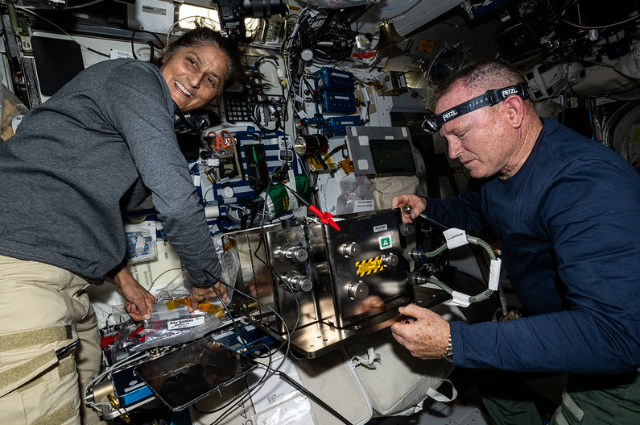NASA astronauts Sunita 'Suni' Williams and Barry 'Butch' Wilmore who travelled to the International Space Station (ISS) aboard Boeing's Starliner spacecraft was initially scheduled to return to Earth last month. However, due to ongoing technical issues, they may have to extend their stay in space until August this year.
Addressing Technical Challenges
Engineers are diligently working to resolve the problems that have caused this delay. During their first press conference from space, Williams and Wilmore addressed the situation by providing updates on their extended mission. The delay stems from several technical difficulties experienced by the Starliner.
Issues with the Starliner
The Starliner faced a series of delays during its launch due to safety concerns. Faulty thrusters and helium leaks were among the primary issues identified. These problems have caused significant delays but engineers are working hard to ensure the spacecraft's safety and reliability.
Confidence in a Safe Return
Despite the unexpected challenges, both astronauts have expressed confidence in the Starliner's ability to bring them back to Earth safely. Williams and Wilmore remain positive about the situation, trusting in the efforts of the engineering team. However, NASA has not yet provided a specific return date for the astronauts.
A Historic Mission
Williams and Wilmore's mission is historic as they are the first human crew to test the Boeing-built Starliner capsule. Their extended stay in space highlights the unpredictable nature of space missions and the importance of rigorous safety measures. As they await their return, the world watches closely hopeful for their safe journey back to Earth.
Confidence in Starliner's Capabilities: Assurance of Safe Return
Sunita 'Suni' Williams, speaking in a CNN report expressed confidence in the Starliner spacecraft's ability to ensure their safe return if necessary. She stated, "I feel confident that, if there was a problem with the International Space Station then we would get in the Starliner spacecraft, communicate with our team and figure out the best way to come home."
Strong Belief in Starliner's Performance
Barry 'Butch' Wilmore echoed this sentiment by emphasizing their faith in Starliner's capabilities. "We're absolutely confident," he affirmed regarding the spacecraft's ability to bring them home safely. Williams added, "I have a real good feeling in my heart that the spacecraft will bring us home, no problem," during a press briefing from the International Space Station.
Feeling at Home in Space
Williams mentioned the familiarity and comfort of being back in the orbiting laboratory. "It feels like home to us," she remarked by highlighting their ease with the extended stay. She also noted that neither she nor Wilmore minded the additional time in space as she quoted saying, "I'm not complaining, Butch isn't complaining that we're here for a couple of extra weeks." This marks Williams' third journey into space and reflects her extensive experience.
Details of the Mission
Williams and Wilmore launched on June 5 aboard a United Launch Alliance Atlas V rocket from Space Launch Complex-41 at Cape Canaveral Space Force Station in Florida. Their mission is part of NASA's Boeing Crew Flight Test by aiming to certify the Starliner for rotational missions under NASA's Commercial Crew Program. They successfully docked with the ISS on June 6 and have been testing Starliner and its subsystems since.
Contributions to ISS Operations
During their stay, Williams and Wilmore have integrated with the seven astronauts already aboard the ISS. They have been assisting with various tasks including scientific experiments and critical maintenance that had been pending. "We've been doing science for them, maintenance, some major maintenance that it's been waiting for a little while, like stuff that's been on the books for a little bit," Williams shared, as reported by CNN.
Starliner’s Role in NASA’s Future Plans
The Starliner is intended to provide NASA with a second commercial crew transport option for low Earth orbit, alongside Elon Musk's SpaceX Dragon capsule. This diversification in crew transportation options is vital for NASA's ongoing and future missions in space exploration.
Ongoing Testing and Daily Duties in Space: Continuous Testing for Future Missions
Sunita 'Suni' Williams and Barry 'Butch' Wilmore are currently on their 35th day in space, engaging in ongoing tests both in orbit and on Earth to support future long-duration missions. Their work is essential for ensuring the success of these missions.
Busy with Science and Maintenance
The two US Navy veterans reported to the media that they have been actively involved in scientific experiments and maintenance tasks on the ISS since their arrival. They recently repaired the station's processor using a new pump delivered by Starliner. Additionally, Williams has been conducting gene sequencing, while Wilmore has been experimenting with a 3-D printed moon microscope.
Integrated into the ISS Crew
Williams mentioned, "We've been thoroughly busy up here," highlighting their integration into the ISS crew which they have nicknamed "Expedition 71-plus." This extended team includes NASA astronauts Michael Barratt, Matt Dominick, Tracy C. Dyson, and Jeanette Epps as well as Roscosmos cosmonauts Nikolai Chub, Alexander Grebenkin and Oleg Kononenko.
Background on NASA's Commercial Crew Program
In 2014, both Boeing and SpaceX received funding from NASA's Commercial Crew Program to transport astronauts to the ISS following the retirement of the Space Shuttle Program in 2011. Boeing was awarded over $4 billion to develop the Starliner, while SpaceX received approximately $2.6 billion.
SpaceX's Crew Dragon Success
Since its inaugural launch on May 30, 2020, SpaceX's Crew Dragon has successfully completed 12 crewed missions to the ISS. This track record emphasizes the progress and reliability of private commercial crew transportation for NASA's space endeavours.
. . .
References:

